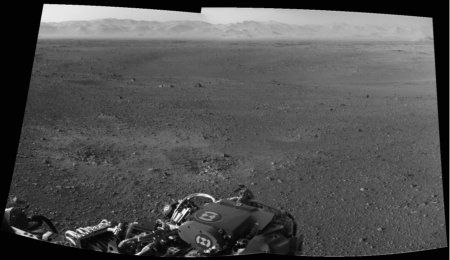Curiosity Lifts Up Its Head
The first pics from Curiosity's Navcam show an Earth-like landscape
And it's up! Curiosity has lifted up the mast containing its main navigational cameras and has snapped this view of the rim of Gale Crater (Curiosity's landing site) using the rover's right Navcam.
At a press conference on Wednesday, project scientist John Grotzinger quipped you'd be "forgiven for thinking NASA was trying to pull a fast one on you" by sending a rover to the Mojave Desert. The landscape may look Earth-like, he said, because it was created by water that flowed from and eroded mountains in the distance. He also called attention to a few splotches on the left hand side of the image, which were made by thrusters that helped deliver the rover to the Martian surface. This "free trenching" has exposed some underling bedrock, which the rover may explore.
Curiosity is still in its initial post-landing health check-out phase, and there are, as you might expect, many more photos on the way. On NASA TV today, the Curiosity team showed a small 360-degree panorama, pieced together from thumbnails, that was taken with the rover's 1-megapixel Navcams. They expect to have a full resolution version of this panorama ready in the next day or two.
Also still to come are images from the rover's Mast Camera (Mastcam), which consists of two 2-megapixel camera systems, one with a telephoto lens and the other with a medium-angle lens. Each can take color pictures and deliver high-definition video.
Image: NASA /JPL/James Canvin
Rachel Courtland, an unabashed astronomy aficionado, is a former senior associate editor at Spectrum. She now works in the editorial department at Nature. At Spectrum, she wrote about a variety of engineering efforts, including the quest for energy-producing fusion at the National Ignition Facility and the hunt for dark matter using an ultraquiet radio receiver. In 2014, she received a Neal Award for her feature on shrinking transistors and how the semiconductor industry talks about the challenge.
